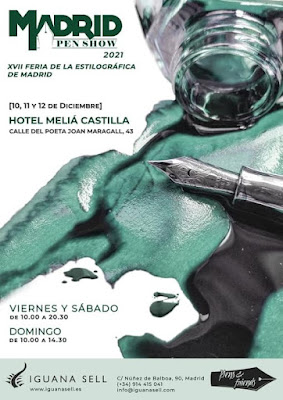In 2015 I wrote
a report on Romillo pens. Now, four years later, and with the operation stopped it might be worth to revisit some of the pens of this short-lived pen brand based in Madrid, Spain.
It started in 2007, created about 10 models –mostly made of SEM ebonite, made in Germany--, implemented Bock and in-house nibs, and disappeared around 2018 (see note at the end) leaving behind a big mess in terms of unpaid commitments.
The body of work left behind, though, deserves some attention.
The following pictures show some of the models by this company.
 From left to right: Nervión, Essential Writer, Sil, Eo, and WiPens Toledo.
From left to right: Nervión, Essential Writer, Sil, Eo, and WiPens Toledo.
From left to right on the previous picture:
– Model Nervión in terracota ebonite. A size 8 Bock nib (18 K) with ebonite feed. Eyedropper. Made in 2011.
– Model Essential Writer in black ebonite. Size 6 Bock nib (18 K), plastic feed. Eyedropper. Made in 2010.
 Sil model.
Sil model.
– Model Sil in red ripple ebonite. Size 6 Bock nib (18 K), plastic feed. Eyedropper. Friction-fit cap. Made in 2012.
 Model Eo with a size 9 nib.
Model Eo with a size 9 nib.
– Model Eo in blue ripple ebonite with celluloid band. In-house size 9 nib (18 K), ebonite feed. Eyedropper. Made in 2013.
 WiPens Toledo. An unsuccessful attempt to create a secondary brand.
WiPens Toledo. An unsuccessful attempt to create a secondary brand.
– WiPens Toledo. Black ebonite. Size 6 Bock nib (14 K), plastic feed. Cartridge-converter. Made in 2013. This pen was not marketed under the Romillo brand, but as WiPens, an attempt to create a second brand for more inexpensive models.
 Starting from the bottom, two Essential, a special version of the Essential with a two tone nib, and an Essential with the in-house flexible nib named K.
Starting from the bottom, two Essential, a special version of the Essential with a two tone nib, and an Essential with the in-house flexible nib named K.
This second collective picture shows a collection of pens of the model Essential. From bottom to top:
– The first two are from 2009. They implement size 6 Bock nibs of 18 K gold with plastic feeds. Eyedropper fillers.
 A very customized version of the model Essential made in 2015.
A very customized version of the model Essential made in 2015.
– The third is a special model made in 2015. The nib is an in-house size 7 made of 18 K gold. Ebonite feed. Eyedropper.
 The in-house K nib. Flexible, but it never worked satisfactorily due, possibly, to an inadequate feed. Essential made in 2012.
The in-house K nib. Flexible, but it never worked satisfactorily due, possibly, to an inadequate feed. Essential made in 2012.
– The fourth (on top) is from 2012. It sports an in-house flexible nib named K, made of 18 K gold. Plastic feed. Eyedropper.
Romillo pens were expensive pens, with an average price of EUR 1000. Was that justified by the quality of the product? The pens here shown are very simple in their structure. Being eyedropper pens they had no movable parts or sacs to be adjusted. Internally, though, we see that all the threads (save in the case of the much more inexpensive WiPens Toledo) are made of brass, and there are elastic seals in the ink deposit to prevent leaks. Were those elements needed or effective?
Were these pens better that, say, most Indian eyedroppers also made of ebonite?
As eyedroppers, both Indian pens and Romillos have the same problem—the tendency to blob ink and ruining the document in progress.
Another problem of several of the Romillo models (Essential, Nervión, Eo) was the basic structure of the pen, with the cap attaching to the section instead of to the barrel. On these pens, uncapping them could result in unscrewing the barrel from the section and opening the ink deposit. This, in an eyedropper pen, is a very serious design flaw.
 The cap attaches to the section instead of to the barrel.
The cap attaches to the section instead of to the barrel.
Paradoxically, the cheapest of the models produced by the Romillo family –the WiPens Toledo- had solved these problems at the price of making a much more conventional pen.
RomilloPens was, all in all, a short-lived operation that left behind a small bunch –about 450-- units of expensive and attractive pens. Despite their flaws.
My thanks to Croma, Eliperin and ValenSpain; all of them members of Spanish pen community.
NOTE (26/Dec/2019): I have corrected the date of cease of activities of RomilloPens to 2018 after some sources mentioned that they could buy some pens as late as that year. Since late 2015 or early 2016, the Romillo family avoided Spanish customers and focused on foreign markets while continuing fixing and tuning nibs. However, this situation did not last for too long and is currently shut down.
WiPens Toledo – Montblanc Irish Green
Bruno Taut
Nakano, December 24th 2019
etiquetas: Romillo, Spain, WiPens
 The Taccia Covenant. Note how the barrel tail sticks out of the cap. This is needed to open and close the pen.
The Taccia Covenant. Note how the barrel tail sticks out of the cap. This is needed to open and close the pen.



























































